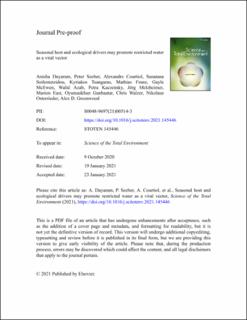| dc.contributor.author | Dayaram, Anisha | |
| dc.contributor.author | Seeber, Peter A | |
| dc.contributor.author | Courtiol, Alexandre | |
| dc.contributor.author | Soilemetzidou, Sanatana-Eirini | |
| dc.contributor.author | Tsangaras, Kyriakos | |
| dc.contributor.author | Franz, Mathias | |
| dc.contributor.author | McEwen, Gayle | |
| dc.contributor.author | Azab, Walid | |
| dc.contributor.author | Kaczensky, Petra | |
| dc.contributor.author | Melzheimer, Jörg | |
| dc.contributor.author | East, Marion | |
| dc.contributor.author | Ganbaatar, Oyunsaikhan | |
| dc.contributor.author | Walzer, Chris | |
| dc.contributor.author | Osterrieder, Nikolaus | |
| dc.contributor.author | Greenwood, Alex D. | |
| dc.coverage.spatial | Central Asia, East Africa | en_US |
| dc.date.accessioned | 2023-03-03T07:53:12Z | |
| dc.date.available | 2023-03-03T07:53:12Z | |
| dc.date.created | 2021-02-09T16:01:46Z | |
| dc.date.issued | 2021 | |
| dc.identifier.issn | 0048-9697 | |
| dc.identifier.uri | https://hdl.handle.net/11250/3055591 | |
| dc.description.abstract | In climates with seasonally limited precipitation, terrestrial animals congregate at high densities at scarce
water sources. We hypothesize that viruses can exploit the recurrence of these diverse animal congrega-
tions to spread. In this study, we test the central prediction of this hypothesis — that viruses employing
this transmission strategy remain stable and infectious in water. Equid herpesviruses (EHVs) were cho-
sen as a model as they have been shown to remain stable and infectious in water for weeks under labo-
ratory conditions. Using fecal data from wild equids from a previous study, we establish that EHVs are
shed more frequently by their hosts during the dry season, increasing the probability of water source
contamination with EHV. We document the presence of several strains of EHVs present in high genome
copy number from the surface water and sediments of waterholes sampled across a variety of mamma-
lian assemblages, locations, temperatures and pH. Phylogenetic analysis reveals that the different EHV
strains found exhibit little divergence despite representing ancient lineages. We employed molecular
approaches to show that EHVs shed remain stable in waterholes with detection decreasing with increas-
ing temperature in sediments. Infectivity experiments using cell culture reveals that EHVs remain
infectious in water derived from waterholes. The results are supportive of water as an abiotic viral vector
for EHV | en_US |
| dc.language.iso | eng | en_US |
| dc.rights | Attribution-NonCommercial-NoDerivatives 4.0 Internasjonal | * |
| dc.rights.uri | http://creativecommons.org/licenses/by-nc-nd/4.0/deed.no | * |
| dc.subject | Water | en_US |
| dc.subject | Viral transmission | en_US |
| dc.subject | Equine herpesviruses | en_US |
| dc.subject | Viral emergence | en_US |
| dc.title | Seasonal host and ecological drivers may promote restricted water as a viral vector | en_US |
| dc.type | Peer reviewed | en_US |
| dc.type | Journal article | en_US |
| dc.description.version | acceptedVersion | en_US |
| dc.rights.holder | © 2021 The Authors | en_US |
| dc.source.volume | 773 | en_US |
| dc.source.journal | Science of the Total Environment | en_US |
| dc.identifier.doi | 10.1016/j.scitotenv.2021.145446 | |
| dc.identifier.cristin | 1888201 | |
| dc.source.articlenumber | 145446 | en_US |
| cristin.ispublished | true | |
| cristin.fulltext | postprint | |
| cristin.qualitycode | 2 | |

